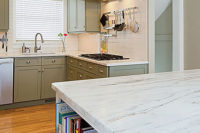
I met with the quarry's general manager, Luca Mannolini, and Todd Robertson, North American sales director, who explained to me that Vermont Quarries' current mission is to increase production and work in a quick and efficient manner to keep up with the demand for the product. "We can produce about 175 to 200 slabs a day," said Robertson. "That's the demand. We know our distributors will take as much marble as we can produce. The goal is to speed up production."
In an effort to meet its goal, the company recently installed a new wire saw, which can cut custom sizes and thicknesses, as well as adding a second gangsaw to its line-up of equipment. "We added the second gangsaw to help keep up with the demand," explained Robertson. "It allows us to set up for specific projects and not disrupt the slabs being cut for distributors [on the other gangsaw]."
In addition to machinery, Vermont Quarries has also beefed up its staff, which allows it to run two shifts. "Keeping up with the demand of our current clients requires two shifts," said Robertson, adding that the company ships approximately 100,000 slabs a month around the country -- not including custom jobs. "The demand is growing."
Mannolini explained that even more important than investing in equipment is finding a premium supply of white marble. "It is import to research and conduct geological studies to find a viable source," he explained. "You can spend millions of dollars on equipment, but it means nothing if you don't have the marble.
"White marble is in demand," said Mannolini. "We hear from our customers that Danby has become a brand name."
Robertson explained that Danby marble is becoming recognized among consumers for its low absorption. "The U.S. is catching on to using white marble for kitchens," he said. "People know the name. We now get requests from around the world."
From my trip to Vermont Quarries, I realize that the demand for white marble countertops is not a trend that will die out any time soon. It also reiterated to me that stone producers want to hear from consumers. They want to hear your concerns, questions, etc., and address them. Education is the key to a successful design.







